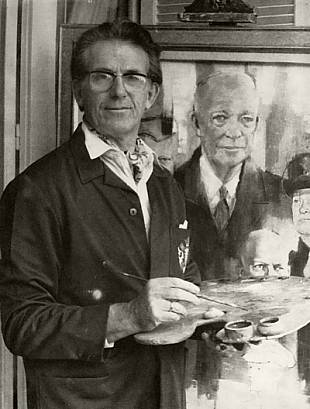Laurent MOONENS is born in 1911 in Brussels, where he spends his youth.
Very soon attracted by painting as a means of expression, he paints his first picture - a composition with flowers - at the age of twelve. He is not yet seventeen when he first attends lectures at the "Académie des Beaux-Arts" in Brussels and then later receives the highest award from the "Institut Supérieur de la Cambre", one of the major Belgian art schools. During his studies, he is already attracted by human expressions and makes regular visits in old age homes where he sketches wrinkled faces.
His first exhibition dates back to 1931. Although the works displayed express how shy and introverted the young artist is, the critics at the time encourage him to go on.
Soon after, MOONENS strikes up a friendship with Jean LAUDY, known as "the Great LAUDY". The prestigious senior artist gives him valuable advice, along with his taste for blooming roses, which they sometimes paint in collaboration.
In the Thirties, MOONENS starts studying at the "Institut Supérieur des Arts Décoratifs de la Cambre" in Brussels to qualify as a commercial artist and in 1939 he is commissioned to design the Pavilion of Labor at the International Exhibition in Liège. Later in his career, he will sign the decoration of the Exhibition of the Katanga Special Committee Fiftieth Anniversary (1950) and of the Congo pavilions at the Bulawayo and Brussels exhibitions (1954 and 1958).
Meanwhile, the Second World War breaks out and MOONENS has to join the Belgian forces. A difficult period in his life, hardly in keeping with his artistic sensitiveness, which expresses itself immediately after the war, through austere, even severe, painting, which nevertheless perspires a significant amount of emotion. In those days, he also paints nudes, bunches of roses and portraits.
During an exhibition, he is encouraged by Her Majesty Queen Elizabeth of Belgium, who is both an art lover and a patron.
Once qualified as an Academy Professor, he teaches Art until 1948, when the Belgian government sends him to Belgian Congo with the mission to promote Art in this large central Africa Belgian colony,
His stay in Africa - and more particularly in the Katanga region - proves to be a decisive turning point in Laurent MOONENS's career.
Admittedly, his early African works - portraits, in particular - are still under European influence. Yet, his sensitiveness gradually changes as he is discovering this fabulous country which filled him with enthusiasm and passion.
Besides, impressed by the local talents he comes across amongst young natives, he founds the Fine Arts Academy in Elizabethville (now Lubumbashi). Instead of imposing an European academic teaching program, MOONENS allows his students to give free course to their inspiration. This will last seven years until the colony's independence, and he feels very regretful when he has to leave the country and his students, amongst which some will become prominent artists.
While he is teaching, Laurent MOONENS makes his own work richer, his colors become livelier, as his lines fit into rhythms only to be found in Africa. During this period, he produces expressionistic compositions, sometimes as if going into a trance. African civilization obviously fascinates the artist, who goes through one of the most fruitful step of his life.
Does he intuitively have a premonition of the dramatic events that will soon affect the territory? Most likely. At the time, some of his paintings display a dramatic tension that gives a hint of the anxiety and despair of the artist, faced by implacable events.
Back in Belgium in 1960, an exhibition of his pictures is set up and provokes considerable interest. The critics praise the signs of a liberated inspiration.
The hazy skies of the Flanders, as romantic as they can be, cannot hold him back any longer and he travels south to the French Riviera, to its brightness and its colors.
Once in France, he has to make himself known to a public who has never heard of him.
Immediately, the region around Nice appeals to him, so he decides to settle in Saint Jeannet with his family. Later, he sets up his studio in Cannes, where he will continue his career for twenty seven years. Under the spell of the Mediterranean coast and Provence, his paintings reflect the light and chroma characteristic of the region.
Saint Jeannet, the mountains, olive trees, lavender fields, inspire him to give his landscapes enlightened colors, both in his oil paints and his watercolors. For his well-known village alleyways - his "ruelles", as he called them -, he composes with shadow and light which are stylized up to the extreme in his "black and white" ink series.
Besides, he establishes his reputation through numerous portraits - more than a thousand of them -, displaying a skill and technique praised by specialists. MOONENS has that rare talent of capturing most facets of a person or an entire family on a single canvas. He projects every bit of this talent into each assignment which includes not only kings, princes and celebrities but also mothers, children and more anonymous models. His work is owned world-wide and is spread through private collections in all five continents.
Through his faultless technique, MOONENS evolves in harmony with the various environments and periods he lives through, but his relentless quest for the absolute keeps guiding him towards new lands to be explored
MOONENS is a loner. He rarely takes part in group exhibitions, remaining faithful to his very own freedom of expression. As he says: "An artist can express himself only through himself."
The subject of his last painting is the face of an old lady, which he completes a few months before his death, in May 1991.
Translated from Suzanne LAURENT

